A Review of Ground Source Heat Pump Application for Space Cooling in Southeast Asia
Abstract
:1. Introduction
2. Subsurface Characteristics and Temperature Survey
3. GSHP Application for Other Purposes
4. Experimental Performance
4.1. Indonesia
4.2. Malaysia
4.3. Singapore
4.4. Thailand
4.4.1. Bangkok Province
4.4.2. Kamphaengphet Province
- -
- 85% of the temperature increase in borehole heat exchangers due to the operation was recovered within 10 days after the operation was stopped.
- -
- Subsurface temperature did not increase considerably over a year of operation.
- -
- A suitable setting for heat-pump operation was required for an effective cooling operation and for electricity consumption reduction (around 0.6 kW). The difference between the minimum and maximum temperatures of the inlet fluid should not be larger than 5 K. Additionally, the recommended minimum setting temperature should not be less than 14 °C.
- -
- CoP value for the stable operation period was approximately 3. The stable operation may continue if the heat-exchange rate is not above 80 W/m.
4.4.3. Pathumthani Province
4.4.4. Saraburi Province
4.5. Vietnam
5. Conclusions
Author Contributions
Funding
Acknowledgments
Conflicts of Interest
References
- Malhi, Y.; Franklin, J.; Seddon, N.; Solan, M.; Turner, M.G.; Field, C.B.; Knowlton, N. Climate change and ecosystems: Threats, opportunities and solutions. Philos. Trans. R. Soc. B 2020, 375, 20190104. [Google Scholar] [CrossRef] [PubMed] [Green Version]
- Montoya, J.M.; Raffaelli, D. Climate change, biotic interactions and ecosystem services. Philos. Trans. R. Soc. B Biol. Sci. 2010, 365, 2013–2018. [Google Scholar] [CrossRef] [PubMed] [Green Version]
- Downing, T.E. Climate Change and World Food Security; Springer Science & Business Media: Berlin/Heidelberg, Germany, 2013; Volume 37. [Google Scholar]
- Tol, R.S. Estimates of the damage costs of climate change, part II. Dynamic estimates. Environ. Resour. Econ. 2002, 21, 135–160. [Google Scholar] [CrossRef]
- Widiatmojo, A.; Chokchai, S.; Takashima, I.; Uchida, Y.; Yasukawa, K.; Chotpantarat, S.; Charusiri, P. Ground-source heat pumps with horizontal heat exchangers for space cooling in the hot tropical climate of Thailand. Energies 2019, 12, 1274. [Google Scholar] [CrossRef] [Green Version]
- Bakirtas, T.; Akpolat, A.G. The relationship between energy consumption, urbanization, and economic growth in new emerging-market countries. Energy 2018, 147, 110–121. [Google Scholar] [CrossRef]
- Doan, V.Q.; Kusaka, H. Projections of urban climate in the 2050s in a fast-growing city in Southeast Asia: The greater Ho Chi Minh City metropolitan area, Vietnam. Int. J. Climatol. 2018, 38, 4155–4171. [Google Scholar] [CrossRef]
- Le, V.T.; Pitts, A. A survey on electrical appliance use and energy consumption in Vietnamese households: Case study of Tuy Hoa city. Energy Build. 2019, 197, 229–241. [Google Scholar] [CrossRef]
- International Energy Agency (IEA). Southeast Asia Energy Outlook 2017; International Energy Agency: Paris, France, 2017. [Google Scholar]
- Lee, Z.H.; Sethupathi, S.; Lee, K.T.; Bhatia, S.; Mohamed, A.R. An overview on global warming in Southeast Asia: CO2 emission status, efforts done, and barriers. Renew. Sustain. Energy Rev. 2013, 28, 71–81. [Google Scholar] [CrossRef]
- Adams, R.M.; Hurd, B.H.; Lenhart, S.; Leary, N. Effects of global climate change on agriculture: An interpretative review. Clim. Res. 1998, 11, 19–30. [Google Scholar] [CrossRef] [Green Version]
- Leiserowitz, A. Climate change risk perception and policy preferences: The role of affect, imagery, and values. Clim. Change 2006, 77, 45–72. [Google Scholar] [CrossRef] [Green Version]
- Urbaniec, M.; Tomala, J.; Martinez, S. Measurements and trends in technological eco-innovation: Evidence from environment-related patents. Resources 2021, 10, 68. [Google Scholar] [CrossRef]
- Banks, D. An Introduction to Thermogeology: Ground Source Heating and Cooling; John Wiley & Sons: Hoboken, NJ, USA, 2012. [Google Scholar]
- Omer, A.M. Ground-source heat pumps systems and applications. Renew. Sustain. Energy Rev. 2008, 12, 344–371. [Google Scholar] [CrossRef]
- Bayer, P.; Saner, D.; Bolay, S.; Rybach, L.; Blum, P. Greenhouse gas emission savings of ground source heat pump systems in Europe: A review. Renew. Sustain. Energy Rev. 2012, 16, 1256–1267. [Google Scholar] [CrossRef]
- Sasada, M.; Takasugi, S.; Tateno, M. A ground source heat pump system in central Tokyo; A case study of retrofit for a small office building. J. Jpn. Soc. Eng. Geol. 2011, 51, 265–272. [Google Scholar] [CrossRef]
- Urchueguía, J.; Zacarés, M.; Corberán, J.M.; Montero, A.; Martos, J.; Witte, H. Comparison between the energy performance of a ground coupled water to water heat pump system and an air to water heat pump system for heating and cooling in typical conditions of the European Mediterranean coast. Energy Convers. Manag. 2008, 49, 2917–2923. [Google Scholar] [CrossRef]
- Zhou, Z.; Zhang, Z.; Chen, G.; Zou, J.; Xu, P.; Meng, C.; Yu, Z. Feasibility of ground coupled heat pumps in office buildings: A China study. Appl. Energy 2016, 162, 266–277. [Google Scholar] [CrossRef]
- Lu, Q.; Narsilio, G.A.; Aditya, G.R.; Johnston, I.W. Economic analysis of vertical ground source heat pump systems in Melbourne. Energy 2017, 125, 107–117. [Google Scholar] [CrossRef]
- Self, S.J.; Reddy, B.V.; Rosen, M.A. Geothermal heat pump systems: Status review and comparison with other heating options. Appl. Energy 2013, 101, 341–348. [Google Scholar] [CrossRef]
- Han, C.; Yu, X.B. Performance of a residential ground source heat pump system in sedimentary rock formation. Appl. Energy 2016, 164, 89–98. [Google Scholar] [CrossRef]
- Yi, M.; Hongxing, Y.; Zhaohong, F. Study on hybrid ground-coupled heat pump systems. Energy Build. 2008, 40, 2028–2036. [Google Scholar] [CrossRef]
- Blum, P.; Campillo, G.; Münch, W.; Kölbel, T. CO2 savings of ground source heat pump systems—A regional analysis. Renew. Energy 2010, 35, 122–127. [Google Scholar] [CrossRef]
- Widiatmojo, A.; Gaurav, S.; Ishihara, T.; Tomigashi, A.; Yasukawa, K.; Uchida, Y.; Kaneko, S.; Yoshioka, M. Experiments using capillary mat as ground heat exchanger for ground source heat pump heating application. Energy Power Eng. 2019, 11, 363–378. [Google Scholar] [CrossRef] [Green Version]
- Fridleifsson, I.B. Geothermal energy for the benefit of the people. Renew. Sustain. Energy Rev. 2001, 5, 299–312. [Google Scholar] [CrossRef] [Green Version]
- Chokchai, S.; Chotpantarat, S.; Takashima, I.; Uchida, Y.; Widiatmojo, A.; Yasukawa, K.; Charusiri, P. A pilot study on geothermal heat pump (GHP) use for cooling operations, and on GHP site selection in tropical regions based on a case study in Thailand. Energies 2018, 11, 2356. [Google Scholar] [CrossRef] [Green Version]
- Liu, X.; Lu, S.; Hughes, P.; Cai, Z. A comparative study of the status of GSHP applications in the United States and China. Renew. Sustain. Energy Rev. 2015, 48, 558–570. [Google Scholar] [CrossRef]
- Chua, K.J.; Chou, S.K.; Yang, W. Advances in heat pump systems: A review. Appl. Energy 2010, 87, 3611–3624. [Google Scholar] [CrossRef]
- Lund, J.W.; Freeston, D.H.; Boyd, T.L. Direct application of geothermal energy: 2005 worldwide review. Geothermics 2005, 34, 691–727. [Google Scholar] [CrossRef]
- Li, X.; Chen, Z.; Zhao, J. Simulation and experiment on the thermal performance of U-vertical ground coupled heat exchanger. Appl. Therm. Eng. 2006, 26, 1564–1571. [Google Scholar] [CrossRef]
- Brandl, H. Energy foundations and other thermo-active ground structures. Géotechnique 2006, 56, 81–122. [Google Scholar] [CrossRef]
- Bi, Y.; Wang, X.; Liu, Y.; Tian, R.; Chen, L.; Wu, C. Applications of ground source heat pump systems in different temperature zones in China. Int. J. Ambient. Energy 2009, 30, 63–72. [Google Scholar] [CrossRef]
- Sagia, Z.; Rakopoulos, C.; Kakaras, E. Cooling dominated hybrid ground source heat pump system application. Appl. Energy 2012, 94, 41–47. [Google Scholar] [CrossRef]
- Man, Y.; Yang, H.; Wang, J. Study on hybrid ground-coupled heat pump system for air-conditioning in hot-weather areas like Hong Kong. Appl. Energy 2010, 87, 2826–2833. [Google Scholar] [CrossRef]
- Man, Y.; Yang, H.; Spitler, J.D.; Fang, Z. Feasibility study on novel hybrid ground coupled heat pump system with nocturnal cooling radiator for cooling load dominated buildings. Appl. Energy 2011, 88, 4160–4171. [Google Scholar] [CrossRef]
- Yik, F.; Burnett, J.; Prescott, I. Predicting air-conditioning energy consumption of a group of buildings using different heat rejection methods. Energy Build. 2001, 33, 151–166. [Google Scholar] [CrossRef]
- Uchida, Y.; Sakura, Y.; Taniguchi, M. Shallow subsurface thermal regimes in major plains in Japan with reference to recent surface warming. Phys. Chem. Earth Parts A/B/C 2003, 28, 457–466. [Google Scholar] [CrossRef]
- Yasukawa, K.; Uchida, Y. Space cooling by ground source heat pump in tropical Asia. In Renewable Geothermal Energy Explorations; IntechOpen: London, UK, 2018. [Google Scholar]
- Yasukawa, K.; Uchida, Y.; Tenma, N.; Taguchi, Y.; Muraoka, H.; Ishii, T.; Suwanlert, J.; Buapeng, S.; Nguyen, T.H. Groundwater temperature survey for geothermal heat pump application in tropical Asia. Bull. Geol. Surv. Jpn. 2009, 60, 459–467. [Google Scholar] [CrossRef] [Green Version]
- Khan, M.H. Modeling, Simulation and Optimization of Ground Source Heat Pump Systems; Oklahoma State University: Stillwater, OK, USA, 2004. [Google Scholar]
- Yang, W.; Zhou, J.; Xu, W.; Zhang, G. Current status of ground-source heat pumps in China. Energy Policy 2010, 38, 323–332. [Google Scholar] [CrossRef]
- Japan Refrigeration and Air Conditioning Industry Association. World Air Conditioner Demand by Region; Japan Refrigeration and Air Conditioning Industry Association: Tokyo, Japan, 2018. [Google Scholar]
- Darma, S.; Imani, Y.L.; Shidqi, N.A.; Dwikorianto, T.; Daud, Y. Country update: The fast growth of geothermal energy development in Indonesia. In Proceedings of the World Geothermal Congress 2020, Reykjavik, Iceland, 24–27 October 2021. [Google Scholar]
- Lund, J.W.; Toth, A.N. Direct utilization of geothermal energy 2020 worldwide review. Geothermics 2021, 90, 101915. [Google Scholar] [CrossRef]
- Fronda, A.; Lazaro, V.; Halcon, R.; Reyes, R.G. Geothermal energy development: The Philippines country update. In Proceedings of the World Geothermal Congress 2020, Reykjavik, Iceland, 24–27 October 2021. [Google Scholar]
- Amatyakul, P.; Boonchaisuk, S.; Rung-Arunwan, T.; Vachiratienchai, C.; Wood, S.H.; Pirarai, K.; Fuangswasdi, A.; Siripunvaraporn, W. Exploring the shallow geothermal fluid reservoir of Fang geothermal system, Thailand via a 3-D magnetotelluric survey. Geothermics 2016, 64, 516–526. [Google Scholar] [CrossRef]
- Owens, L. Initial Assessment of High Potential Geothermal Sites in Northern Thailand; Ormat Technologies. Inc.: Reno, NV, USA, 2012; p. 8. [Google Scholar]
- Raksaskulwong, M. Update on geothermal utilizations in Thailand. Update 2015, 19, 25. [Google Scholar]
- Ngoc, N.L.; Giang, C.D.; Cuong, N.T. Geothermal research and current development of geothermal energy in Vietnam. In Proceedings of the World Geothermal Congress 2010, Bali, Indonesia, 25–29 April 2010. [Google Scholar]
- Cuong, N.T.; Giang, C.D.; Thang, T.T. General evaluation of the geothermal potential in Vietnam and the prospect of development in the near future. In Proceedings of the World Geothermal Congress 2005, Antalya, Turkey, 24–29 April 2005. [Google Scholar]
- Permchart, W.; Tanatvanit, S. Study on using the ground as a heat sink for a 12,000-Btu/h modified air conditioner. Int. J. Agric. Biosyst. Eng. 2009, 3, 120–123. [Google Scholar]
- Khedari, J.; Permchart, W.; Pratinthong, N.; Thepa, S.; Hirunlabh, J. Field study using the ground as a heat sink for the condensing unit of an air conditioner in Thailand. Energy 2001, 26, 797–810. [Google Scholar] [CrossRef]
- Bruelisauer, M.; Meggers, F.; Leibundgut, H. Choosing your heat sink for cooling in tropical climates. In The Role of Building Physics in Resolving Carbon Reduction Challenge and Promoting Human Health in Building, Proceedings of the 5th International Building Physics Conference (IBPC), Kyoto, Japan, 28–31 May 2012; Kyoto University: Kyoto, Japan, 2012. [Google Scholar]
- Giang, N.D.; Ichinose, M.; Sasaki, R.; Tokuda, E. Assessment of energy consumption as a performance index in high-rise buildings in Hanoi, Vietnam. J. Build. Perform. 2017, 8, 2017. [Google Scholar]
- Yasukawa, K.; Takashima, I.; Uchida, Y.; Tenma, N.; Lorphensri, O. Geothermal heat pump application for space cooling in Kamphaengphet, Thailand. Bull. Geol. Surv. Jpn. 2009, 60, 491–501. [Google Scholar] [CrossRef]
- Takashima, I.; Yasukawa, K.; Uchida, Y.; Yoshioka, M.; Won-in, K. A geothermal heat pump system in Bangkok, Thailand. In Proceedings of the 9th Asian Geothermal Symposium, Ibusuki, Japan, 7–9 November 2011. [Google Scholar]
- Liu, Y.; Qin, X.; Chiew, Y. Investigation on potential applicability of subsurface cooling in Singapore. Appl. Energy 2013, 103, 197–206. [Google Scholar] [CrossRef]
- Shimada, Y.; Uchida, Y.; Takashima, I.; Chotpantarat, S.; Widiatmojo, A.; Chokchai, S.; Charusiri, P.; Kurishima, H.; Tokimatsu, K. A study on the operational condition of a ground source heat pump in Bangkok based on a field experiment and simulation. Energies 2020, 13, 274. [Google Scholar] [CrossRef] [Green Version]
- Widiatmojo, A.; Shimada, Y.; Takashima, I.; Uchida, Y.; Chotpantarat, S.; Charusiri, P.; Navephap, J.; Tran, T.T. Evaluation and short-term test on potential utilization of ground source heat pump for space cooling in southeast Asia. In Advances in Sustainable Construction and Resource Management; Springer: Berlin/Heidelberg, Germany, 2021; pp. 745–770. [Google Scholar]
- Miyara, A.; Tarakka, R.; Mochtar, A.A.; Anis, I.R.M. Thermal performance of shallow spiral-tube ground heat exchanger for ground-source cooling system. In Materials Science and Engineering; IOP Conference Series; IOP Publishing: Bristol, UK, 2019; Volume 619. [Google Scholar]
- Roy, D.; Chakraborty, T.; Basu, D.; Bhattacharjee, B. Feasibility and performance of ground source heat pump systems for commercial applications in tropical and subtropical climates. Renew. Energy 2020, 152, 467–483. [Google Scholar] [CrossRef]
- Man, Y.; Yang, H.; Diao, N.; Liu, J.; Fang, Z. A new model and analytical solutions for borehole and pile ground heat exchangers. Int. J. Heat Mass Transf. 2010, 53, 2593–2601. [Google Scholar] [CrossRef]
- Cui, P.; Li, X.; Man, Y.; Fang, Z. Heat transfer analysis of pile geothermal heat exchangers with spiral coils. Appl. Energy 2011, 88, 4113–4119. [Google Scholar] [CrossRef]
- Man, Y.; Yang, H.; Diao, N.; Cui, P.; Lu, L.; Fang, Z. Development of spiral heat source model for novel pile ground heat exchangers. Hvac&R Res. 2011, 17, 1075–1088. [Google Scholar]
- Li, M.; Lai, A.C. Heat-source solutions to heat conduction in anisotropic media with application to pile and borehole ground heat exchangers. Appl. Energy 2012, 96, 451–458. [Google Scholar] [CrossRef]
- Zarrella, A.; Capozza, A.; de Carli, M. Analysis of short helical and double U-tube borehole heat exchangers: A simulation-based comparison. Appl. Energy 2013, 112, 358–370. [Google Scholar] [CrossRef]
- Zarrella, A.; de Carli, M.; Galgaro, A. Thermal performance of two types of energy foundation pile: Helical pipe and triple U-tube. Appl. Therm. Eng. 2013, 61, 301–310. [Google Scholar] [CrossRef]
- Miyara, A. Thermal performance and pressure drop of spiral-tube ground heat exchangers for ground-source heat pump. Appl. Therm. Eng. 2015, 90, 630–637. [Google Scholar]
- Dehghan, B.; Sisman, A.; Aydin, M. Parametric investigation of helical ground heat exchangers for heat pump applications. Energy Build. 2016, 127, 999–1007. [Google Scholar] [CrossRef]
- Fauzi, A.; Rahman, W.M.N.W.A.; Jauhari, Z. Utilization waste material as stabilizer on kuantan clayey soil stabilization. Procedia Eng. 2013, 53, 42–47. [Google Scholar] [CrossRef] [Green Version]
- Mohammed, H.G. The thermal characteristics of some highly weathered soils of peninsular Malaysia. MARDI Res. Bull. 1985, 13, 219–224. [Google Scholar]
- Yusof, T.; Anuar, S.; Ibrahim, H. Numerical investigation of ground cooling potential for Malaysian climate. Int. J. Automot. Mech. Eng. 2014, 10, 2081. [Google Scholar] [CrossRef]
- Inter-Ministerial Committee on Sustainable Development (IMCSD). A Lively and Livable Singapore: Strategies for Sustainable Growth; Inter-Ministerial Committee on Sustainable Development: Singapore, 2009. [Google Scholar]
- Ampofo, F.; Maidment, G.; Missenden, J. Review of groundwater cooling systems in London. Appl. Therm. Eng. 2006, 26, 2055–2062. [Google Scholar] [CrossRef]
- Newman, L.; Herbert, Y. The use of deep water cooling systems: Two Canadian examples. Renew. Energy 2009, 34, 727–730. [Google Scholar] [CrossRef]
- Yang, H.; Cui, P.; Fang, Z. Vertical-borehole ground-coupled heat pumps: A review of models and systems. Appl. Energy 2010, 87, 16–27. [Google Scholar] [CrossRef]
- Jusuf, S.K.; Wong, N.H.; Hagen, E.; Anggoro, R.; Hong, Y. The influence of land use on the urban heat island in Singapore. Habitat Int. 2007, 31, 232–242. [Google Scholar] [CrossRef]
- Supasa, T.; Hsiau, S.; Lin, S.; Wongsapai, W.; Wu, J. Household energy consumption behaviour for different demographic regions in Thailand from 2000 to 2010. Sustainability 2017, 9, 2328. [Google Scholar] [CrossRef] [Green Version]
- Sriamonkul, W.; Intarajinda, R.; Tongsuk, N.; Saengsuwan, S.; Bhasaputra, P.; Pattaraprakorn, W. Life cycle cost analysis of air conditioning system for residential sector in Thailand. GMSARN Int. J. 2011, 5, 131–138. [Google Scholar]
- Zhai, X.; Yu, X.; Yang, Y.; Wang, R.Z. Experimental investigation and performance analysis of a ground-coupled heat pump system. Geothermics 2013, 48, 112–120. [Google Scholar] [CrossRef]
- Luo, J.; Rohn, J.; Bayer, M.; Priess, A.; Wilkmann, L.; Xiang, W. Heating and cooling performance analysis of a ground source heat pump system in Southern Germany. Geothermics 2015, 53, 57–66. [Google Scholar] [CrossRef]
- Lund, J.W.; Boyd, T.L. Direct utilization of geothermal energy 2015 worldwide review. Geothermics 2016, 60, 66–93. [Google Scholar] [CrossRef]
- Dehkordi, S.E.; Schincariol, R.A. Effect of thermal-hydrogeological and borehole heat exchanger properties on performance and impact of vertical closed-loop geothermal heat pump systems. Hydrogeol. J. 2014, 22, 189–203. [Google Scholar] [CrossRef]
- Sommer, W.T.; Doornenbal, P.J.; Drijver, B.C.; Van Gaans, P.F.M.; Leusbrock, I.; Grotenhuis, J.T.C.; Rijnaarts, H.H.M. Thermal performance and heat transport in aquifer thermal energy storage. Hydrogeol. J. 2014, 22, 263–279. [Google Scholar] [CrossRef]
- Yoshioka, M.; Takakura, S.; Uchida, Y. Estimation of groundwater flow from temperature monitoring in a borehole heat exchanger during a thermal response test. Hydrogeol. J. 2018, 26, 853–867. [Google Scholar] [CrossRef]
- Tenma, N.; Yasukawa, K.; Takashima, I.; Uchida, Y.; Lorphensri, O.; Zyvoloski, G. Subsurface thermal influence of experimental geothermal heat pump system operation for space cooling in Kamphaengphet, Thailand. Bull. Geol. Surv. Jpn. 2009, 60, 503–509. [Google Scholar] [CrossRef] [Green Version]
- Zyvoloski, G.; Dash, Z.; Kelkar, S. FEHMN 1.0: Finite Element Heat and Mass Transfer Code; Los Alamos National Laboratory: Santa Fe, NM, USA, 1992. [Google Scholar]
- Tenma, N.; Yasukawa, K.; Zyvoloski, G. Model study of the thermal storage system by FEHM code. Geothermics 2003, 32, 603–607. [Google Scholar] [CrossRef]
- Tago, M.; Morita, K.; Sugawara, M.; Fujita, T.; Iwasashi, T. Heat extraction characteristics of a double U-Tube downhole heat exchanger. J. Geotherm. Res. Soc. Jpn. 2004, 26, 317–331. [Google Scholar]
- Dasare, R.R.; Saha, S.K. Numerical study of horizontal ground heat exchanger for high energy demand applications. Appl. Therm. Eng. 2015, 85, 252–263. [Google Scholar] [CrossRef]
- Congedo, P.M.; Colangelo, G.; Starace, G. CFD simulations of horizontal ground heat exchangers: A comparison among different configurations. Appl. Therm. Eng. 2012, 33, 24–32. [Google Scholar] [CrossRef]
- Kim, M.J.; Lee, S.R.; Yoon, S.; Jeon, J.S. Evaluation of geometric factors influencing thermal performance of horizontal spiral-coil ground heat exchangers. Appl. Therm. Eng. 2018, 144, 788–796. [Google Scholar] [CrossRef]
- Fujii, H.; Nishi, K.; Komaniwa, Y.; Chou, N. Numerical modeling of slinky-coil horizontal ground heat exchangers. Geothermics 2012, 41, 55–62. [Google Scholar] [CrossRef]
- Fujii, H.; Yamasaki, S.; Maehara, T.; Ishikama, T.; Chou, N. Numerical simulation and sensitivity study of double-layer Slinky-coil horizontal ground heat exchangers. Geothermics 2013, 47, 61–68. [Google Scholar] [CrossRef]
- Bertermann, D.; Klug, H.; Morper-Busch, L. A pan-European planning basis for estimating the very shallow geothermal energy potentials. Renew. Energy 2015, 75, 335–347. [Google Scholar] [CrossRef]
- Bryś, K.; Bryś, T.; Sayegh, M.A.; Ojrzyńska, H. Subsurface shallow depth soil layers thermal potential for ground heat pumps in Poland. Energy Build. 2018, 165, 64–75. [Google Scholar] [CrossRef]
- Gan, G. Dynamic thermal performance of horizontal ground source heat pumps—The impact of coupled heat and moisture transfer. Energy 2018, 152, 877–887. [Google Scholar] [CrossRef] [Green Version]
- Ghasemi-Fare, O.; Basu, P. Influences of ground saturation and thermal boundary condition on energy harvesting using geothermal piles. Energy Build. 2018, 165, 340–351. [Google Scholar] [CrossRef]
- Lan, T.T.N.; Thoa, N.T.P.; Nishimura, R.; Tsujino, Y.; Yokoi, M.; Maeda, Y. Atmospheric corrosion of carbon steel under field exposure in the southern part of Vietnam. Corros. Sci. 2006, 48, 179–192. [Google Scholar] [CrossRef]
- Nguyen, A.-T.; Reiter, S. A climate analysis tool for passive heating and cooling strategies in hot humid climate based on Typical Meteorological Year data sets. Energy Build. 2014, 68, 756–763. [Google Scholar] [CrossRef]
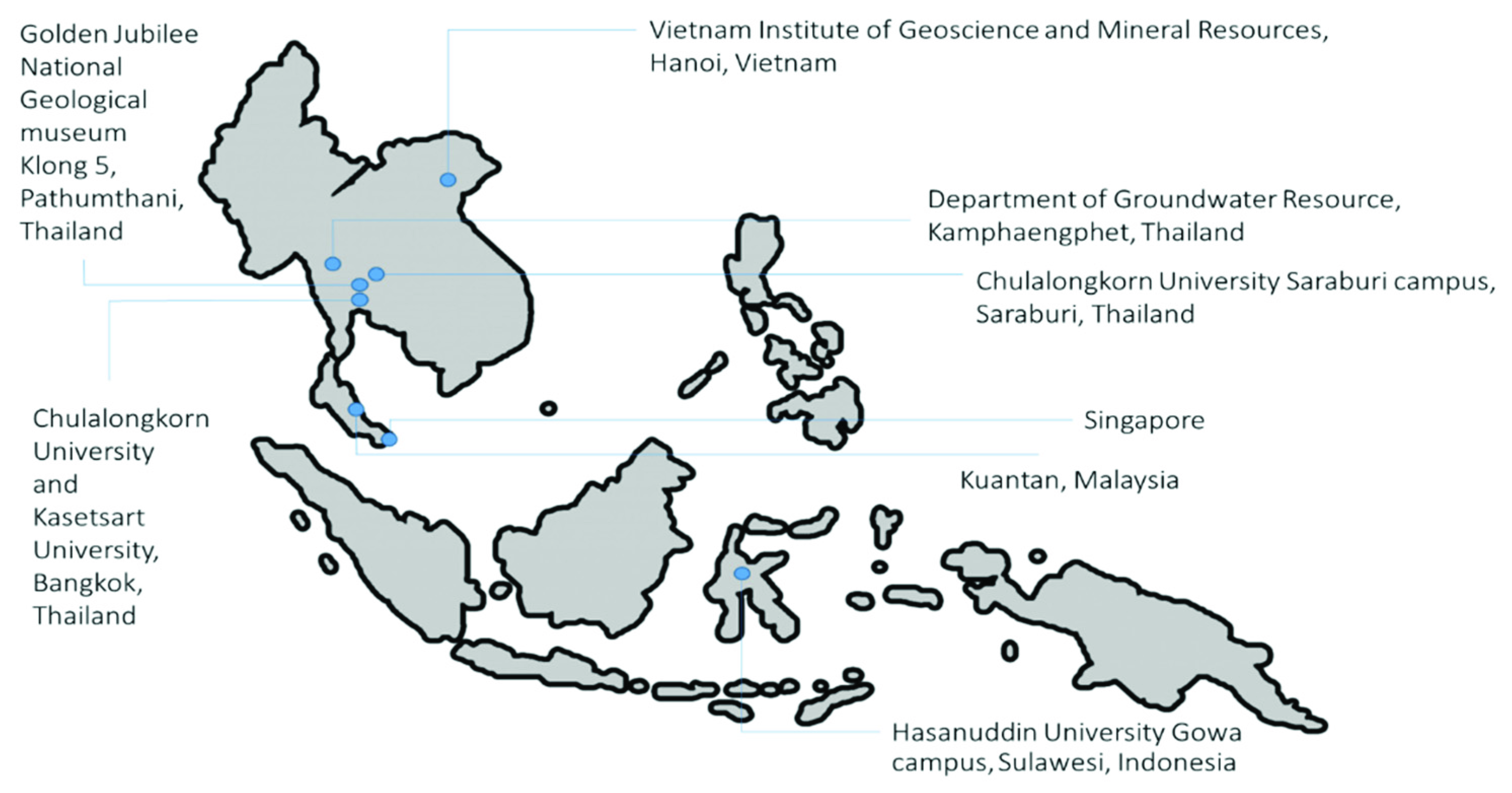
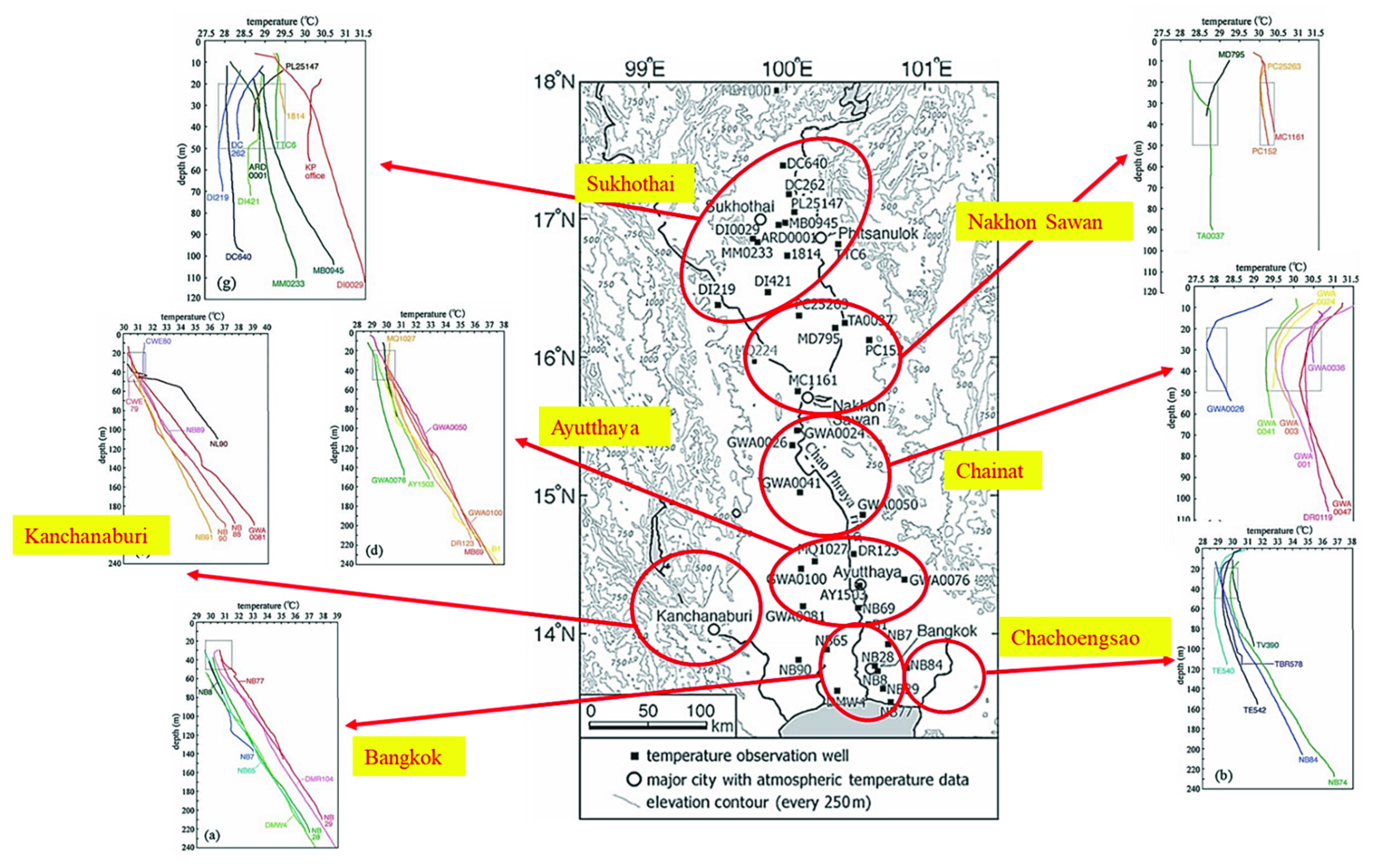


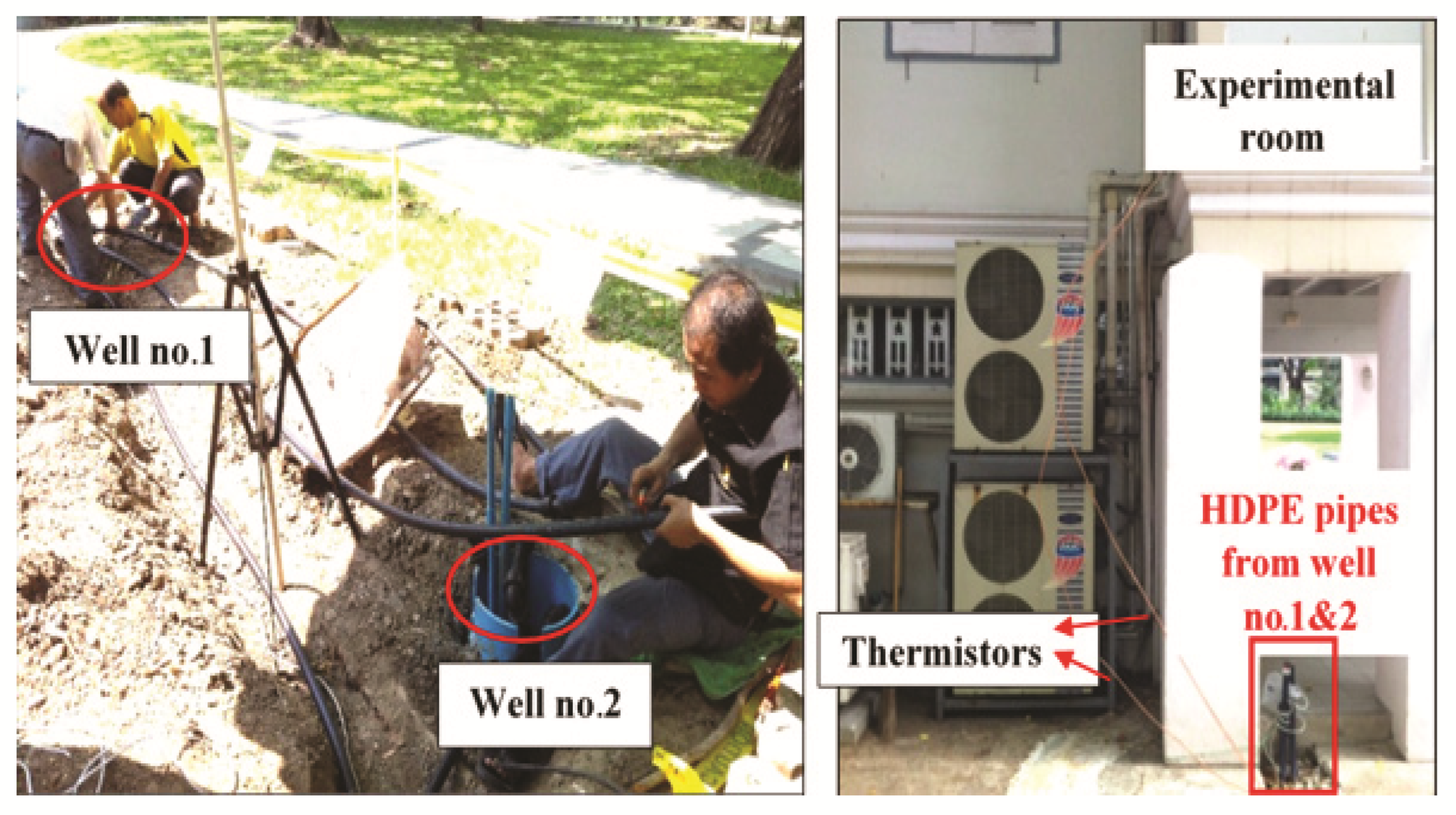
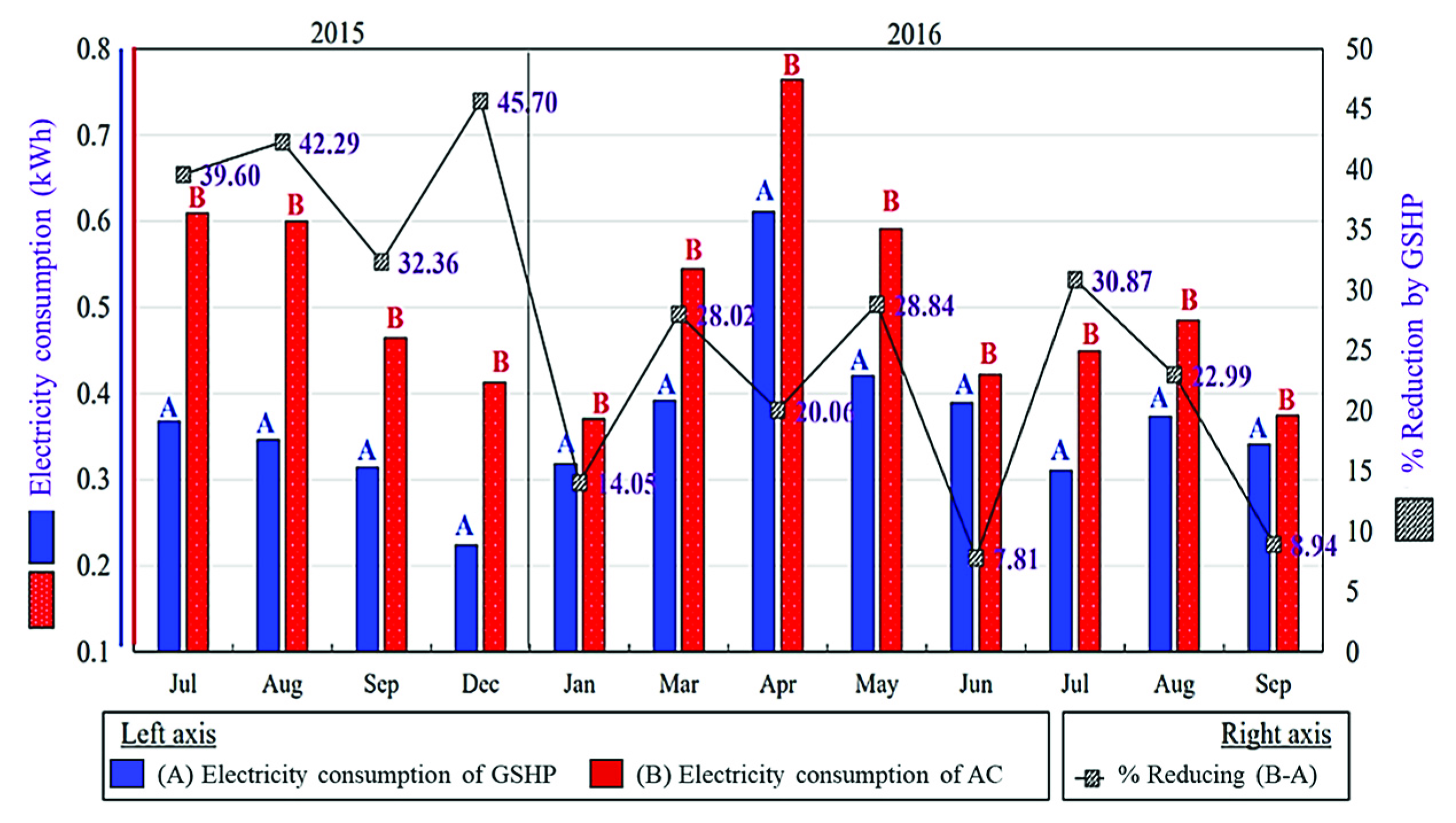

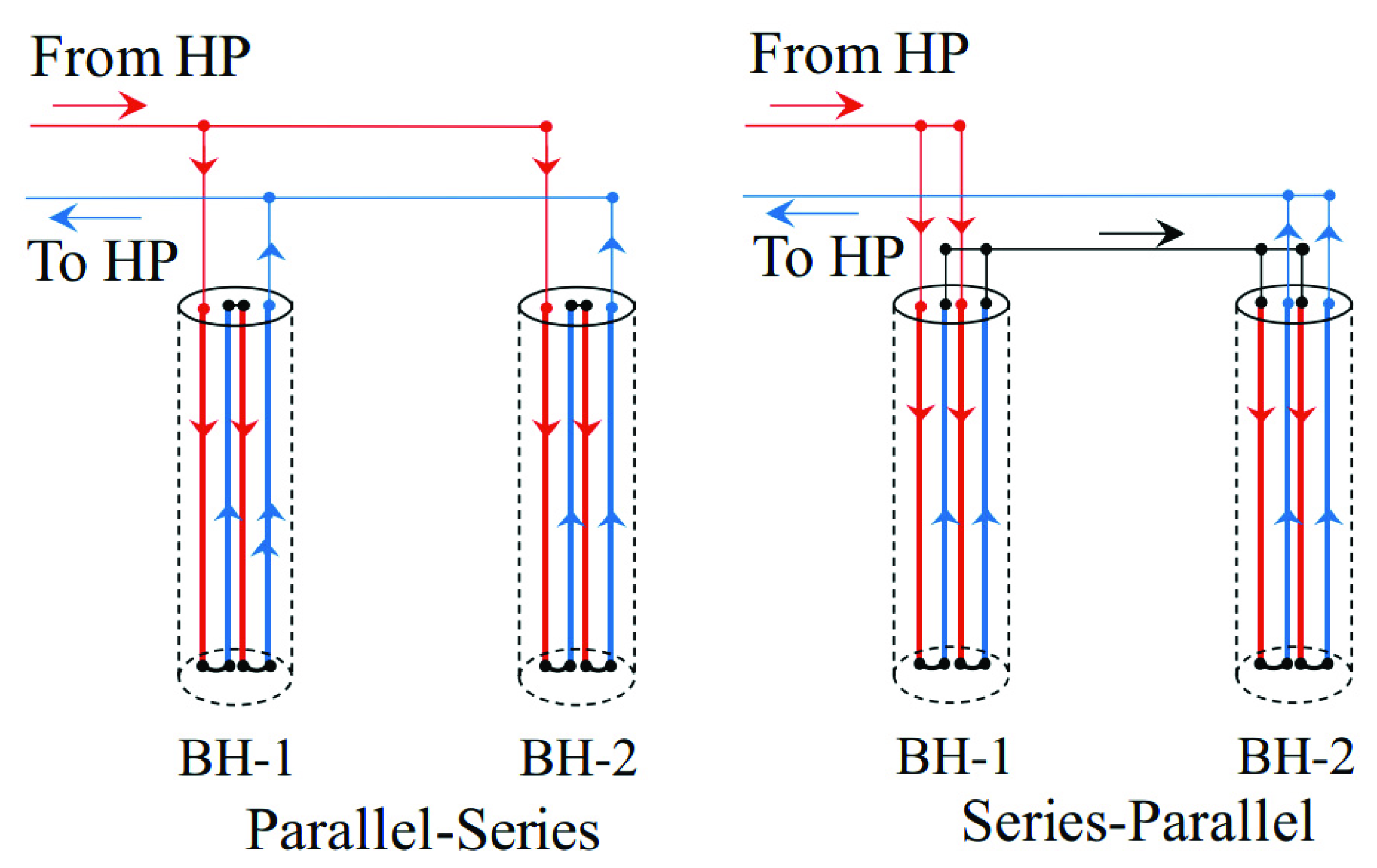
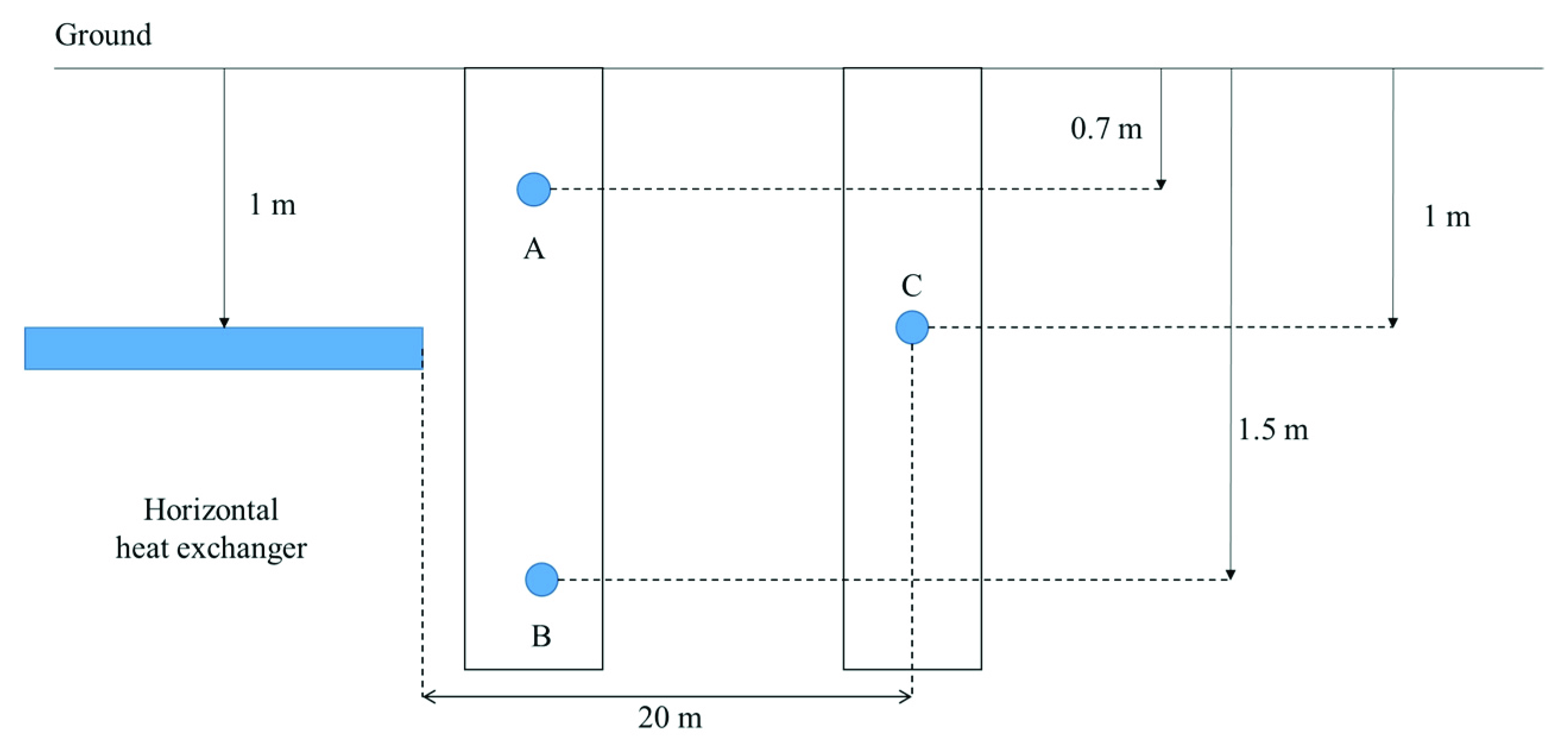
| Locations | Operational Period | Subsurface Heat Exchanger | Average Subsurface Temperature (°C) | Performance | Reference |
|---|---|---|---|---|---|
| Kamphaengphet, Thailand | October 2006– March 2008 | 57-m deep borehole with double U-tube | 30.1–30.6 | CoP of 3 | [56] |
| Kasetsart University, Bangkok, Thailand | July 2010– 2012 | 200-m horizontal tube | 26–29 | CoP of 3–4 | [57] |
| Singapore | 2013 | Simulation mode: 1. Open loop with a cooling tower 2. Open loop without a cooling tower 3. A surface water cooling system | 27 | Approximately 25% energy saving compared with the conventional AC | [58] |
| Chulalongkorn University (Bangkok, Thailand) | May 2014–2019 | Two 50-m deep borehole with a single U-tubes | 29–30 | CoP of 3.45 | [27,59] |
| Chulalongkorn University (Saraburi, Thailand) | November 2016–present | 300-m carpet style and 300-m coil style | 30–32 | CoP of 5.53–5.66 | [5] |
| Geology Museum (Pathumthani, Thailand) | March 2015–present | 50-m deep borehole with double U-tube × 2 (400 m) | N/A | The average CoP of series-parallel configuration was 2.30; the average CoP of parallel-series configuration was 2.54 | [60] |
| Vietnam Institute of Geosciences and Mineral Resources, VIGMR (Hanoi, Vietnam) | October 2016–present | 50-m deep borehole with double U-tube × 2 (400 m) | 27.2 | CoP of 3.1 for cooling and 3.6 for heating | [60] |
| Hasanuddin University Gowa campus, Indonesia | 2018 | 3-m deep borehole with shallow spiral-tube ground heat exchanger × 3 | 27–28 | An average heat exchange rate of series configuration was 86.2 W/m, while that of parallel configuration was 122.4 W/m | [61] |
| Kuantan, Malaysia | 2019 | Simulated vertical GHE | 27.6 | CoP of 3.3 achieved via simulation | [62] |
Publisher’s Note: MDPI stays neutral with regard to jurisdictional claims in published maps and institutional affiliations. |
© 2022 by the authors. Licensee MDPI, Basel, Switzerland. This article is an open access article distributed under the terms and conditions of the Creative Commons Attribution (CC BY) license (https://creativecommons.org/licenses/by/4.0/).
Share and Cite
Ratchawang, S.; Chotpantarat, S.; Chokchai, S.; Takashima, I.; Uchida, Y.; Charusiri, P. A Review of Ground Source Heat Pump Application for Space Cooling in Southeast Asia. Energies 2022, 15, 4992. https://doi.org/10.3390/en15144992
Ratchawang S, Chotpantarat S, Chokchai S, Takashima I, Uchida Y, Charusiri P. A Review of Ground Source Heat Pump Application for Space Cooling in Southeast Asia. Energies. 2022; 15(14):4992. https://doi.org/10.3390/en15144992
Chicago/Turabian StyleRatchawang, Sorranat, Srilert Chotpantarat, Sasimook Chokchai, Isao Takashima, Youhei Uchida, and Punya Charusiri. 2022. "A Review of Ground Source Heat Pump Application for Space Cooling in Southeast Asia" Energies 15, no. 14: 4992. https://doi.org/10.3390/en15144992






